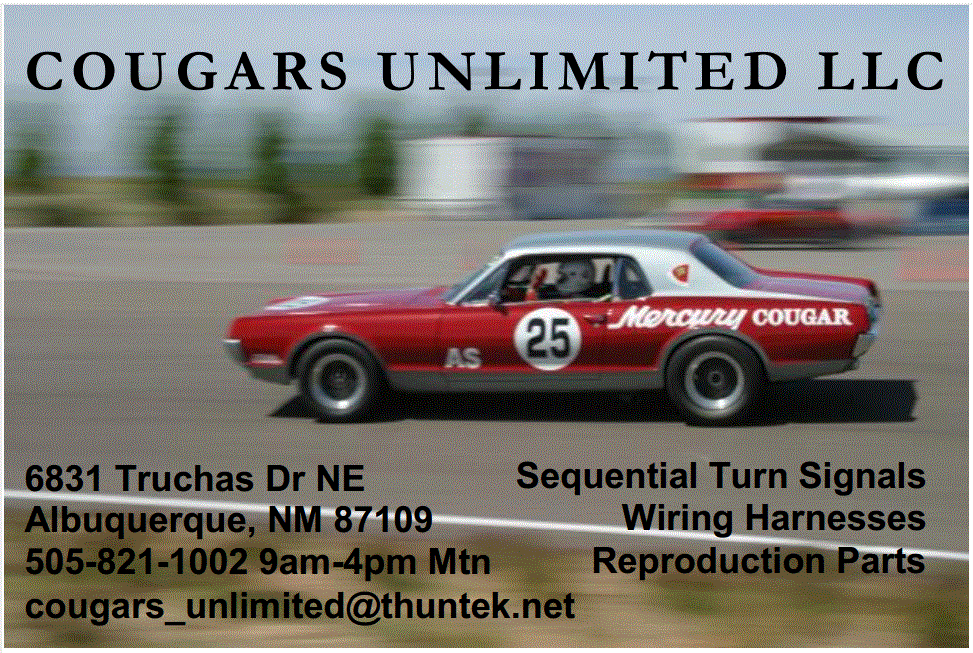

Troubleshooting 1965-66 Ford Thunderbird Sequential Turn Signals
This article covers troubleshooting 1965-1966 Ford Thunderbird sequential turn signals. The turn signal system has five electro-mechanical parts: the turn signal switch, (located in the steering column), a turn signal relay (located under the dash on the pedal support), a directional relay, and a motor-driven sequential flasher located in the trunk behind the backseat . The 1966 Town series also has a pair of emergency flasher relays bolted to the upper trunk level floor just to the right of the spare tire. The most failure prone parts are the mechanical sequential flasher, the turn signal switch, and the stop lamp relay. Circuit diagrams may be found in the appropriate year factory shop manual.
Basically, the system works as follows: when the directional lever on the turn signal switch is moved, it completes circuits that select and feed power to the corresponding bank of lights. Power for the lights is fed through the turn signal relay to the sequencer. The sequencer has three cams that, when rotated, depress switches corresponding to the inboard, center, and outboard tail lights. The power is then routed to the directional relay. This two-sectioned (right and left) relay routes power through to the selected bank of lights. Since brake lights are not sequenced, the directional relay allows all lights to turn on simultaneously when the brake light power feed is energized. But when the turn signal switch is actuated, the brake light power feed is disconnected and the turn signal feed is activated to allow the directional signal to override the brake lights.
Now that you understand a little about how your turn signal system works, you can start troubleshooting. You will need a VOM (Volt-Ohm-Meter) and the circuit diagram for your year car. The most common complaints are: no turn signals, one or more lights on but not flashing, and one or more lights flashing. Obviously, the first place to check is the fuse in the fuse box. The next item is to check all bulbs and their sockets. If these are all good, then now the real sleuthing must begin!
No turn signals:
When the turn signal lever is depressed, no lights come on anywhere. Listen to the directional relay for a click while moving the turn signal lever. If there is no sound, disconnect the turn signal switch from the harness and check it according to Table 1. The table shows wire pairs that should be shorted together when the switch is in the position indicated. If any of the connections are open, replace the switch. Usually the switch has failed when the plastic around the riveted contacts appears to be burnt or melted. This can only be seen with the steering wheel removed.
LEFT TURN |
RIGHT TURN |
| Brown, Yellow | Brown, Red |
| White, Orange-Yellow, Orange-Black | Violet, Orange-Yellow, Orange-Black |
Table 1. 1965 or 1966 Turn signal switch connections
Some or all lights on but not flashing:
This usually means that the motor in the sequential flasher has quit. Remove the white cover from the sequencer and see if the motor is turning the cam. FORD has discontinued the unit but an electronic replacement is available from your parts dealer.
Indicator lights on fender not flashing:
The directional indicator relay (under the dash) is calibrated to flash the indicator lights only when all four 1157 lamps (3 in rear, 1 in front) are on. A burned out bulb can cause the indicator lights to stop flashing. Heavy loads on the system (AC, headlights on, brake lights on) can also cause this problem. The directional indicator relay can weaken with age and cause these symptoms. LED lights will also cause these symptoms because the relay calibration is for the heavier current load of the 1157 bulbs. An electronic relay is available to solve this problem.
One or more lights flashing:
If all bulbs are OK, the trouble is most likely in the sequential flasher or the directional relay. The switch contacts erode away with age. sometimes they can be cleaned up with an ignition points file, but this is just a temporary fix. The best solution is to replace the sequential flasher with an electronic unit. If the directional relay is bad, a replacement is available.
Brake lights on all the time:
First, check the brake light switch under the dash. If the switch is not stuck on, then the stop lamp relay in the trunk is bad.
Emergency flashers not working:
First, check the flasher can under the dash. On the 1966 Town series cars, one of the emergency flasher relays located on the upper trunk shelf next to the spare tire may be bad. Check for a clicking noise from these relays when the emergency flasher button is pressed. Check for power through these relays.
Description |
1965-1966 Thunderbird ------ (before 11/17/1965) |
1966 Thunderbird ----------- (from 11/17/65) |
| OEM PARTS | ||
| Turn indicator relay (under dash) | C5SZ-13A366-C | C5SZ-13A366-C |
| Directional relay (in trunk) | C7WY-13A366-A (labeled C6SB-13A366-A) | C7WY-13A366-A (labeled C6SB-13A366-A) |
| Sequential flasher | C5SZ-13350-A | C5SZ-13350-A |
| Turn signal switch (w/o cruise) | C5SZ-13341-B | C5SZ-13341-B |
| Stop light relay | C5SZ-13482-A (with 3-pins) | C7SZ-13482-B (with 4-pins) |
| REPLACEMENT PARTS | ||
| Electronic system replaces: sequential flasher, directional relay and stop lamp relay | C5SZ-13A366-AS (with 3-pin stop light relay) |
C6SZ-13A366-AS ( with 4-pin stop light relay) |
| Electronic sequential flasher | TE-1 | TE-1 |
| Turn indicator relay (under dash) | C5SZ-13A366-CR | C5SZ-13A366-CR |
| Directional relay | C7WY-13A366-AR | C7WY-13A366-AR |
| Stop light relay | C5SZ-13A366-AR (3-pin) | C7SZ-13482-BR (4-pin) |
Table 2. Turn Signal Parts list
10/28/17 TBSEQTS
© Copyright Cougars Unlimited LLCBack to Cougars Unlimited LLC Home Page